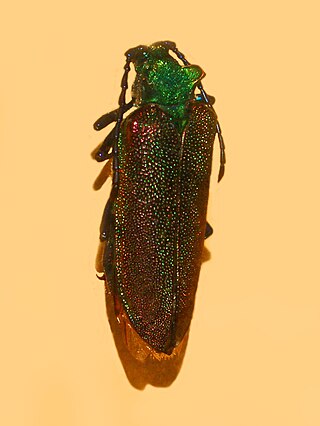
A larva is a distinct juvenile form many animals undergo before metamorphosis into their next life stage. Animals with indirect development such as insects, amphibians, or cnidarians typically have a larval phase of their life cycle.

The insects of the beetle family Chrysomelidae are commonly known as leaf beetles, and include over 37,000 species in more than 2,500 genera, making up one of the largest and most commonly encountered of all beetle families. Numerous subfamilies are recognized, but the precise taxonomy and systematics are likely to change with ongoing research.

An instar is a developmental stage of arthropods, such as insects, which occurs between each moult (ecdysis) until sexual maturity is reached. Arthropods must shed the exoskeleton in order to grow or assume a new form. Differences between instars can often be seen in altered body proportions, colors, patterns, changes in the number of body segments or head width. After shedding their exoskeleton (moulting), the juvenile arthropods continue in their life cycle until they either pupate or moult again. The instar period of growth is fixed; however, in some insects, like the salvinia stem-borer moth, the number of instars depends on early larval nutrition. Some arthropods can continue to moult after sexual maturity, but the stages between these subsequent moults are generally not called instars.

The longhorn beetles (Cerambycidae), also known as long-horned or longicorns, are a large family of beetles, with over 35,000 species described.

The huhu beetle is a longhorn beetle endemic to New Zealand. It is the heaviest beetle found in New Zealand.

The giant Fijian long-horned beetle is native to the island of Viti Levu in Fiji, and is one of the largest living insect species, with specimens around 15 cm long, excluding legs, antennae, or jaws. It is closely related to the Taveuni beetle, which is only marginally smaller. These beetles have powerful jaws, and should be handled with care when alive—when threatened, they produce a loud and fearsome hissing noise by squeezing air out from under their elytra. The rainforest habitat on its home island has suffered severe fragmentation by deforestation and habitat degradation by invasive species such as the small Indian mongoose, with other threats being cyclones that could devastate its remaining habitat, light pollution and human consumption of its larvae. Consequently, the beetle is regarded as rare and endangered.

The timberman beetle is a species of woodboring beetle belonging to the longhorn beetle family.

Gracillariidae is an important family of insects in the order Lepidoptera and the principal family of leaf miners that includes several economic, horticultural or recently invasive pest species such as the horse-chestnut leaf miner, Cameraria ohridella.

Chahuis or xamoes are the common names given in Mexico to a variety of edible insects within the insect order Coleoptera (beetles).

Spondylidinae are a small subfamily of Cerambycidae including slightly over 100 species, primarily in the coniferous forests of the Boreal hemisphere. A few species occur in coniferous forests in tropical and subtropical areas, while very few genera are present in Austral Africa and Madagascar. Some sources spell the name as Spondylinae.

The Disteniidae are a small family of beetles in the superfamily Chrysomeloidea, traditionally treated as a group within the Cerambycidae.

The Oxypeltidae are a small family belonging to the superfamily Chrysomeloidea, widespread in the Andean region of Chile and Argentina. They have traditionally been considered a group within the Cerambycidae.

The Vesperidae are a small family of beetles, normally classified within the family Cerambycidae, of heterogeneous aspect but all characterised by larval stages related to roots of herbaceous plants or trees

The Trictenotomidae are a small family of beetles in the superfamily Tenebrionoidea, containing fifteen species in two genera. Most species are found in the Oriental realm where they live in montane forest habitats. The family is considered, based on larval characters as well as sequence-based studies, to be closely related to the Salpingidae.

Acanthinodera is a genus of longhorned beetles in the family Cerambycidae. It is monotypic, being represented by the single species Acanthinodera cumingii. It is the largest species of beetle in Chile. The beetle is endemic to central Chile and can be found from IV Coquimbo Region to IX La Araucanía Region.

Sphenostethus is a genus of beetles in the family Cerambycidae. It is monotypic, being represented by the single species Sphenostethus taslei.

Taeniotes scalatus is a species of flat-faced longhorn beetle in the subfamily Lamiinae of the family Cerambycidae.

Phoracantha semipunctata, the Australian Eucalyptus longhorn, is a species of beetle in the family Cerambycidae. Native to Australia, it has now spread to many parts of the world, including practically all countries where tree species of Eucalyptus have been introduced. It has been classified as an invasive pest species of Eucalyptus outside Australia.

Etorofus anthracinus is a species of beetle in the family Cerambycidae. It was first described by John Lawrence LeConte in 1875. They are found in North America and can be observed seeking the dead parts of living trees for development.

Iberodorcadion fuliginator is a species of beetle in the family Cerambycidae. It was described by Carl Linnaeus in his landmark 1758 10th edition of Systema Naturae. It is known from Central Europe: Spain, Belgium, Luxembourg, Netherlands, Portugal, France, Germany, Austria, Lithuania, and Switzerland.




















